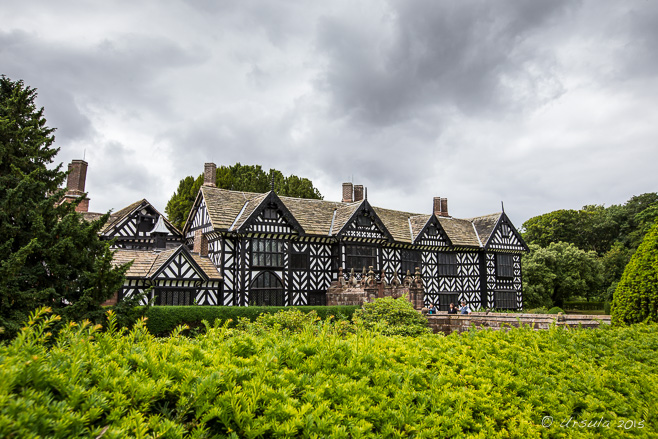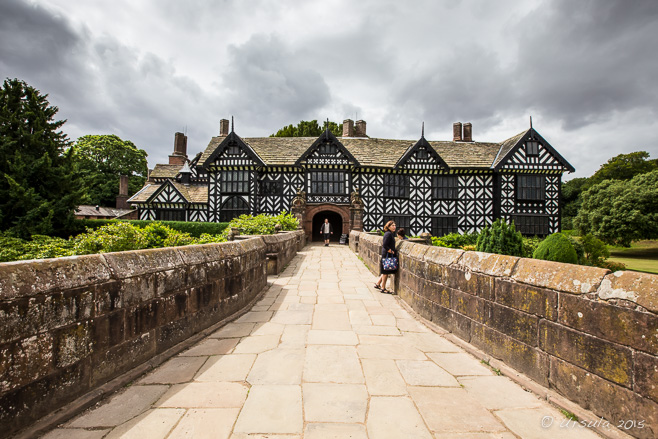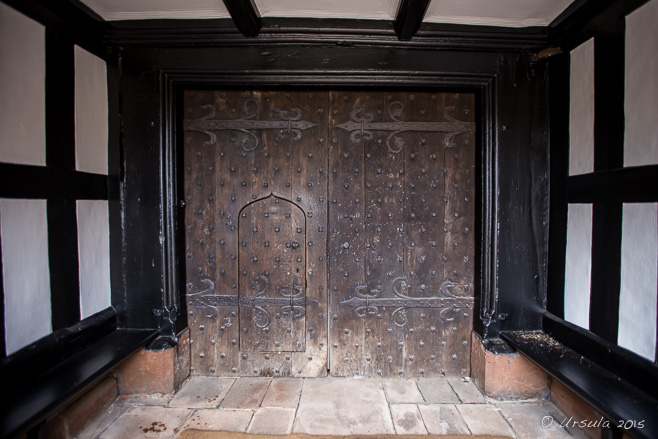
Speke Hall, Liverpool
Set upon a commodious property, this old Tudor manor retains much of its stately grace under the management of the National Trust.
Call it fate; call it co-incidence; call it what you will: my family has strong ties to Liverpool.
My father moved his new bride from Europe to his Liverpool, UK, home after their marriage, and I was subsequently born there. I spent a few years there (which I mostly don’t remember!) until my parents and I emigrated to Canada when I was a toddler – before I acquired the distinctive “Scouser” accent. I made my first trip back to “the old country” as a young adult, and it was in England that I met the Australian who became my partner. He, funnily enough, was from Liverpool – Australia – and both my children grew up in that Liverpool area.
My daughter moved to the UK several years ago, and was nursing in a war zone when she met the man she would marry. He was from (you guessed it) Liverpool, UK. In fact, it turns out that his mother and I were born in the same hospital!
So, we are back in England at the moment: for the marriage of my Australian daughter to her British man. And, I couldn’t resist visiting Liverpool again: with my husband and adult son, to show them some of my roots (see: The Mersey).
My first trip back to England was a revelation to me: after growing up in a land with a relatively young Western history, the ancient stories represented in the stones and walls of the cities and buildings was awesome. More amazingly, as I was taken around the city of my birth by an elderly relative, I learned that my own great-grandparents had met while working as servants in Speke Hall, an old house which is now maintained by the National Trust, and open to the public.
Speke Hall is an almost 500-year-old Tudor timber-framed manor house with Victorian improvements, and is well worth a visit – even if your family didn’t live and work there!
Built between 1530 and 1598 by the family of William Norris II – Catholics during a time of religious tumult in England – the original house included a priest’s hole hidden in the walls and attic. Spy holes and an eavesdropper ensured that visitors could be vetted and any priest in residence could hide in time. Towards the end of the 18th century, the Norris’ moved to the more fashionable London, and the building fell into disrepair. There was a time when it was even used as a cow shed!
The dilapidated estate was sold in 1795 to Richard Watt, who made his money in Jamaican sugar. Over subsequent generations, the fortunes of the house rose and fell, before being inherited by Miss Adelaide Watt when she turned 21 in 1878. She lived in the hall until her death in 1921, and under trust arrangements, much of the farm property was sold – later becoming the site of the Liverpool Aerodrome – and the house was looked after by her butler and staff until it became property of the National Trust in 1943.
What remains of the grounds, on the banks of the River Mersey, is still extensive. The property features playgrounds and picnic grounds; a new Victorian-themed hedge maze; traditional formal gardens established in the 1860s; a large kitchen garden that dates back further and still supplies the coffee shop; expansive lawns; and ancient woodlands. Wandering around the house and gardens, it is easy to forget where (and when) you are – until a jet from Liverpool’s John Lennon Airport next door roars low overhead.

Speke Hall
The approach to the old house is over the old moat.

Front Doors
Our entry to the house was through the small inset in the heavy front door. What we can’t see is the “eavesdrop” overhead: the listening tube that allows servants to listen in to what we might be saying.

Tudor Courtyard
Construction on the house began in 1530, and around that time two yew trees ( ‘Adam’ and ‘Eve’) were planted in the courtyard of the main building.

Tudor Details
Although few of the lines in the wattle and daub house are straight or level after all these years, the details are still beautiful.

Volunteer David
We missed the formal guided tours of the house – available on a first-come, first-serve basis – but we were able to wander through it on our own. In each open room, a National Trust Volunteer was stationed to tell us about the history and features.

Ancient Yews: Dreamcatchers
Guide David told us that the two yew trees, ‘Adam’ and ‘Eve,’ acted as “dreamcatchers”: preventing evil forces from entering the house. These trees are now some 500 years old.

Delft and Fireplace
The morning room is where Miss Adelaide would have her breakfast and meet tradesmen. It is a small world: the last time I saw Delft ceramic tiles was in a Mogul palace in Rajasthan.

Library
Original William Morris wallpaper was added by Frederick Leyland during his ten-year tenancy from 1867.

“Metal Mickey”

Tudor Fireplace in the Great Hall
(The English are so polite: rather than nasty signs, sprigs of holly are place on the fragile chairs to make people think twice before sitting down!)

Woodwork Details
All around the house, ornately carved oak panels, many depicting stories of the Norris family, decorate walls and furniture.

The Blue Parlour
Victorian elegance with stained glass windows and strong>Louis XV furniture.

Plant in the Hallway
I love the leaded windows: a sign of riches in Tudor times.

Leaded Windows
From the upstairs hallway, one looks out over the courtyard.

Servant’s Bells
“Below stairs” are the very bells that my great-grandparents would have listened out for.

Servant’s Bells
Charles Wall worked as a coachman from the early 1890s. Louise (Louisa) Ashley was a housemaid. They married and left the house for independent lives early 1895 or so.

Downstairs Diningroom
The size of the servants’ dining room gives an indication of how many staff were employed. Many stayed on for life.

Tudor Guide
Back outside, a volunteer guide in Tudor period costume, prepares for the afternoon tour groups.
Before leaving the heritage property, we stopped in the repurposed farm buildings which now operate as coffee shop and souvenir sales. Traditional favourites like “scouse” (“lobscous”, a lamb or beef stew); a local version of a vegetable pasty; were on offer.
 Truly, a glimpse into times past.
Truly, a glimpse into times past.
‘Till next time –
Happy Travels!
Pictures: 21July2015






















.jpg)


My great grandmother is Norris. She married Edwards. This is our family heritage manor. I was born in Maryborough QLD. Australia. My mother, Elaine, has original documents. My sister has visited this wonderful heritage home of our family. My mobile, as I do not do emails, is 0423602836. Australian mobile phone.
Hello, Judith!
It really is a wonderful old building, full of stories. I hope your sister enjoyed visiting it.
– Ursula